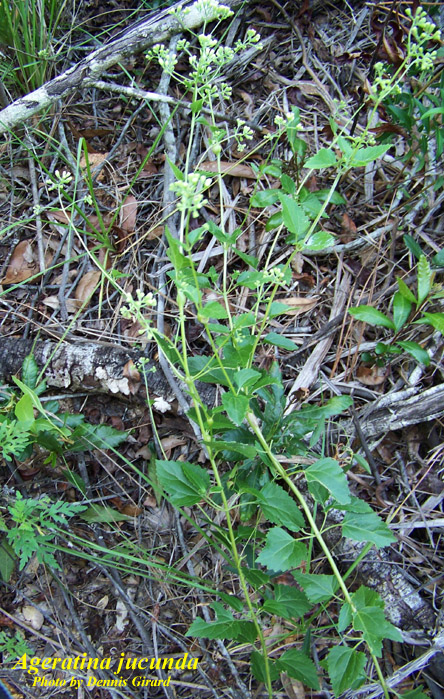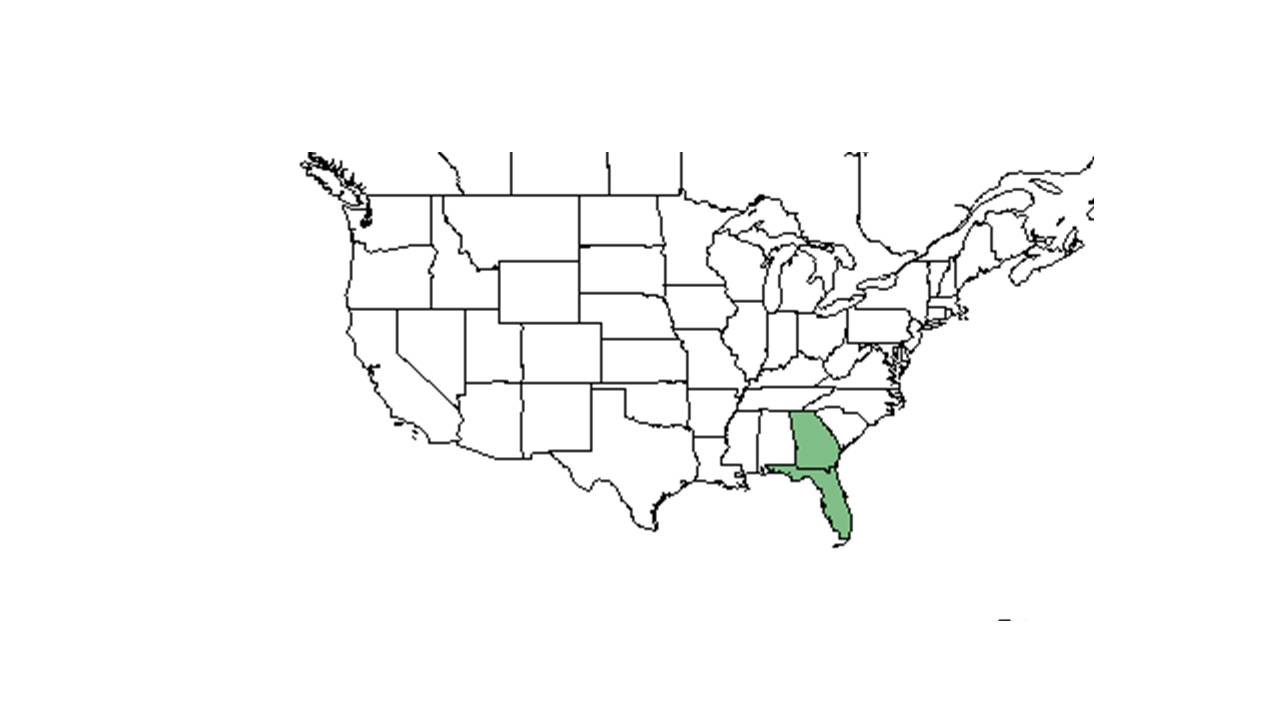Difference between revisions of "Ageratina jucunda"
Krobertson (talk | contribs) |
Krobertson (talk | contribs) (→Conservation, cultivation, and restoration) |
||
| Line 56: | Line 56: | ||
==Conservation, cultivation, and restoration== | ==Conservation, cultivation, and restoration== | ||
| − | ''Ageratina jucunda'' becomes threatened by habitat loss and fire | + | ''Ageratina jucunda'' becomes threatened by habitat loss and fire exclusion.<ref name="Natureserve"/> |
==Cultural use== | ==Cultural use== | ||
Revision as of 12:19, 21 March 2023
| Ageratina jucunda | |
|---|---|

| |
| Photo by Dennis Girard, Atlas of Florida Vascular Plants | |
| Scientific classification | |
| Kingdom: | Plantae |
| Division: | Magnoliophyta - Flowering plants |
| Class: | Magnoliopsida - Dicotyledons |
| Order: | Asterales |
| Family: | Asteraceae ⁄ Compositae |
| Genus: | Ageratina |
| Species: | A. jucunda |
| Binomial name | |
| Ageratina jucunda (Greene) Clewell & Woot. | |

| |
| Natural range of Ageratina jucunda from USDA NRCS Plants Database. | |
Common names: Hammock snakeroot; Small leaf thoroughwort
Contents
Taxomomic notes
Synonym: Eupatorium jucundum Greene.[1]
Description
A description of Ageratina jucunda is provided in The Flora of North America.
The root system of Ageratina jucunda includes root tubers which store non-structural carbohydrates (NSC) important for both resprouting following fire and persisting during long periods of fire exclusion.[2]. Diaz-Toribio and Putz (2021) recorded this species to have an NSC concentration of 42.4 mg/g (ranking 79 out of 100 species studied) and water content of 43.0% (ranking 76 out of 100 species studied).[2]
Distribution
Ageratina jucunda is endemic to the southeastern United States, only known to occur in Florida and a few counties in Georgia. [3]
Ecology
Habitat
This species is found in a wide variety of habitat types including longleaf pine-saw palmetto, dunes, rocky environments, ecotone from scrub oak sand ridge to shrub bog, stream banks, dry flatwoods,[4] pine scrubs, and longleaf pine-turkey oak sand ridges. It can also occur in abandoned fields, along roadsides[3] and their ditches,[5] phosphate quarries in hardwoods, rocky plantation pastures, and edges of field tracks.[6] On the Florida panhandle, it occurs in sand pine scrub, wooded sand ridges, dunes, hammocks, and roadsides.[5]
Soils include loamy sand Entisols and sandy, periodically saturated Spodosols with high humus content. This species thrives in environments with moderate shade to high light conditions.[5]
Associated species incldue Solidago stricta, Sabal palmetto, Serenoa repens, Quercus virginiana, Quercus laurifolia, Eupatorium petaloideum, Thelypteris, Woodwardia, Arnoglossum diversifolium, Quercus laevis, Liatris tenuifolia, Pityopsis graminifolia, Liatris elegans, Pinus palustris and, Aristida stricta.[6]
Phenology
Ageratina jucunda has been observed flowering August through January and fruiting August through December.[6][7] It is reported to bloom in the Florida panhandle (Gadsden, Leon, Wakulla counties) from September through January.[5]
In north Florida, it has been observed to reproduce with A. aromatica suggesting these species are possibly conspecific.[8]
Seed bank and germination
In growing zone ecotypes 8, 9, and 10, A. jucunda will flower within 6 months following germination.[9]
Fire ecology
A. jucunda is an associate species of longleaf pine and wiregrass communities maintained by periodic fires. Fire exclusion would ultimately create conditions without sufficient light to support A. jucunda.[3]
Herbivory and toxicology
This species contains tremetol, a complex alcohol and glycoside that can cause a fatal disease known as staggers in cattle. The toxin is capable of being passed through milk and can cause fatalities in humans who consume infected milk.[10]
Conservation, cultivation, and restoration
Ageratina jucunda becomes threatened by habitat loss and fire exclusion.[3]
Cultural use
Photo Gallery
References and notes
- ↑ Weakley, A.S. 2015. Flora of the southern and mid-atlantic states. Working Draft of 21 May 2015. University of North Carolina at Chapel Hill, Chapel Hill, North Carolina.
- ↑ 2.0 2.1 Diaz-Toribio, M.H. and F. E. Putz 2021. Underground carbohydrate stores and storage organs in fire-maintained longleaf pine savannas in Florida, USA. American Journal of Botany 108: 432-442.
- ↑ 3.0 3.1 3.2 3.3 Natureserve http://www.natureserve.org/, accessed 15 May 2015.
- ↑ Flora of North America http://floranorthamerica.org/, accessed 15 May 2015.
- ↑ 5.0 5.1 5.2 5.3 Observation by Roger Hammer in Tosohatchee Wildlife Management Area, Orange County, FL, posted to Florida Flora and Ecosystematics Facebook Group February 18, 2017.
- ↑ 6.0 6.1 6.2 Florida State University Robert K. Godfrey Herbarium database. URL: http://herbarium.bio.fsu.edu. Last accessed: June 2014. Collectors: Jame Amoroso, Bian Tan, John B. Nelson, O. Lakela, J. P. Gillespie, Robert K. Godfrey, Robert L. Lazor, John Lazor, W. G. D'Arcy, Robert Kral, Elmer C. Prichard, Andre F. Clewell, Loran C. Anderson, K. Craddock Burks, H. S. Conard, E. Bell, and Jean W. Wooten. States and Counties: Florida: Columbia, Volusia, Hillsborough, Marion, Taylor, Alachua, Sarasota, Sumter, Polk, Citrus, St. Johns, Leon, Hernando, Jefferson, Suwanee, and Levy.
- ↑ Nelson, G. PanFlora: Plant data for the eastern United States with emphasis on the Southeastern Coastal Plains, Florida, and the Florida Panhandle. www.gilnelson.com/PanFlora/ Accessed: 7 DEC 2016
- ↑ Clewell, A. F. and J. W. Wooten (1971). "A Revision of Ageratina (Compositae: Eupatorieae) from Eastern North America." Brittonia 23(2): 123-143.
- ↑ Observation by Scott Allen Davis posted to Florida Flora and Ecosystematics facebook Group, February 18, 2017.
- ↑ [[1]]Accessed:March 22, 2016